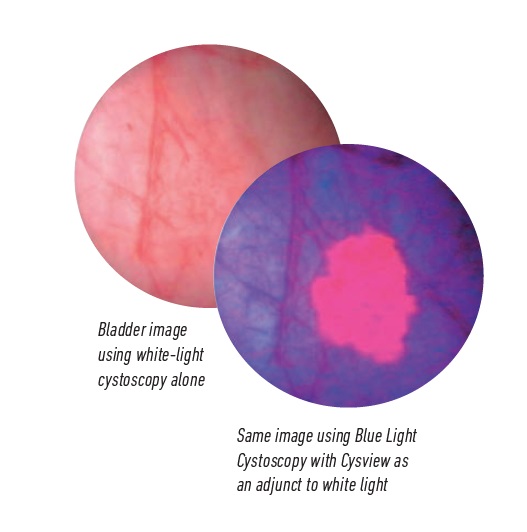For some bladder cancer patients, Fox Chase now offers a revolutionary diagnostic and treatment approach called Blue Light Cystoscopy with Cysview (BLCC) that is designed to improve detection and removal of early stage bladder cancer with greater accuracy and to reduce recurrence.
When symptoms and blood tests suggest that you may have bladder cancer, doctors do a visual inspection of the interior wall of the bladder using a cystoscope — a thin tube with a light and video camera on the end — in a procedure called a cystoscopy.
While larger nonmuscle invasive bladder cancer (NMIBC) tumors may be visible using white light, smaller cancerous areas may not be easily detected because their color can look the same as surrounding healthy tissue.

In the new BLCC approach, doctors use a cystoscope equipped with both white and blue light and administer an optical-imaging drug called Cysview (hexaminolevulinate HCl) that is absorbed by cancer cells. When viewed under the blue light, early stage tumors and lesions glow pink against the healthy tissue, which shows up blue.
BLCC may be appropriate in the following circumstances:
- An initial White Light Cystoscopy inspection or biopsy detects early stage bladder cancer (nonmuscle invasive bladder cancer or NMIBC)
- As a follow-up to BCG bladder cancer treatment
- Presence of multiple low-grade tumors
- Re-evaluation four to six weeks after removal of tumors and lesions
- Positive cytology (blood tests for presence of cancer cells) and a negative White Light Cystoscopy
- Assessment of bladder cancer tumors
Research shows that chances of recurrence are significantly reduced with BLCC because surgeons can perform a more complete removal of the cancer.
Fox Chase is among a select number of institutions around the country to offer this approach, which is included in bladder cancer guidelines recommended by the American Urological Association (AUA) and the Society of Urological Oncology (SUO).
